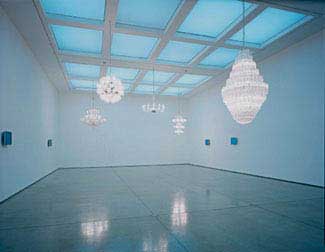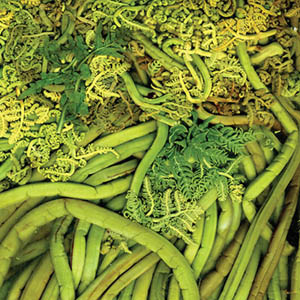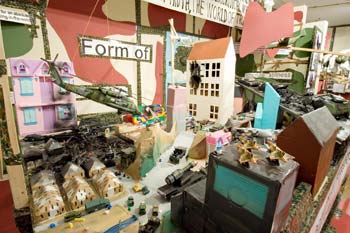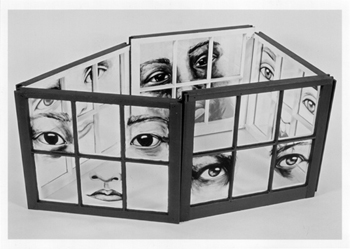Big Red & Shiny: AN INTERVIEW WITH WILLIAM STOVER
|
By REESE INMAN
Cerith Wyn Evans’ first solo US museum survey was presented at the Museum of Fine Arts, Boston, from Oct 6, 2004 – Jan 30, 2005. The exhibition included an installation of seven crystal chandeliers, each intermittently flashing Morse code translations of various texts, with both the texts and their Morse code translations displayed on computer screens set into the gallery walls. Below, William Stover, Assistant Curator of Contemporary Art, discusses his interest in Wyn Evans’ work, the decision process surrounding this particular installation of artwork involving technology, responses to the exhibition, and the idea of Synthetic Art. RI: How did your interest in Cerith Wyn Evans’ work develop? WS: I was immediately struck by Cerith’s work upon seeing it for the first time at the Tate in 2000. There was a small project at the Tate, and as part of that exhibition, he showed an earlier piece of which there were a number of incarnations, a computer with the same sort of Morse code unit attached that we showed here, but attached to a different kind of a light; it was attached to a sort of a floodlight or spotlight that was projected onto a disco ball revolving around, hence you had light twirling all over the walls and the visitors as they walked into the exhibition. I think that you can become fascinated with a lot of Cerith’s work on an emotional or a bodily level before intellectualizing it. There’s something visually stunning about it that makes you want to stop and ask more, to read more, to think about the work, and walking into this installation I was just blown away by it, and started to think about his work and look at it more. There was a wonderful quote in conjunction with the concurrent William Blake exhibition at the Tate: “When I picture my words, I see them flying around the perimeter of a room”. That quote struck Cerith, and he took the poems of William Blake, translated them into Morse code, and flashed them on the disco ball, so William Blake’s words were actually flying around the perimeter of the room. I was struck by this relationship, not only the relationship of Cerith and William Blake, but by this relationship of looking at older work, and looking at previous artists, looking at a writer, looking at another artist, and having their work make meaning for you as an artist, and having that translate into your own work. I find that really fascinating. So after seeing that piece, which resonated with me for a long time, I found information about Cerith, I contacted the gallery, I did all the things you do when you’re interested in someone’s work, and at that time I was in New York at the New Museum, and I was really interested in trying to do something with him, and it never came about, so I arrived here at the MFA with him sort of in the back of my mind. A number of years later, I was at Documenta, and saw another version of the disco ball piece, in a huge room in the exhibition hall at Documenta, and I came back, people asked me about what I had seen and what had impressed me, and the only thing I could talk about was Cerith again. And I was really interested in this body of work that deals with light and language. So through a series of conversations, Cerith and I came up with what was in the exhibition, though a number of things that I wanted to show couldn’t be done for various reasons. Because of the constraints of the gallery, we actually changed the exhibition about halfway through the planning stages, moving the chandeliers to another gallery. They were originally supposed to have been installed in the far left hand side of Foster Gallery, and we moved them into the Rabb Gallery, which for me changed the work in a really interesting way. When the chandelier pieces were installed in the traditional white cube, they were very high, and the work felt very different. In the Rabb Gallery installation, the chandeliers functioned more as sculptures. They were hung much lower, there was a relationship to your body, you could almost hug them. Also, we opened the windows for that space, allowing a little more light in to change the dynamic of the space, and the space has wooden floors and molding as opposed to the cement floors in the other galleries, it’s more of a traditional gallery, so when we were thinking about moving to that space, we were able to do something here that wasn’t able to be done in previous exhibitions of the chandeliers, and that is put them in a context, a historical context. You could enter the gallery from the West Wing contemporary gallery, or from the American galleries, which include decorative arts objects like chandeliers. Cerith’s really involved with looking at artists, philosophers, and writers, but he’s also interested in art history, in objects, and a number of things coming out of different kinds of histories. To be able to somehow put them back into history really interested him, so he was happy about moving the chandeliers to the Rabb Gallery. RI: How did you approach the challenge of presenting the technological aspect of the work to the art going public, which represents all levels of techno-savviness or lack thereof? WS: Well, that’s an interesting question, because it’s one of those things where, you know, on different levels you always want to sort of tell someone something. And on another level you want them to have the experience, you don’t want to say, this show is about X, or Cerith’s work is about X. Cerith was not so much interested in people knowing about the technology, per se, although there are a number of technologies working in those particular pieces, but he was interested in people knowing about Morse code, because he was fascinated with the idea of language and the idea of encryption. It’s really interesting, this idea of language, this idea of communication that is really not communicating, because it’s there and it’s happening, but you’re not part of it. The inspiration for the chandelier pieces came from Cerith’s experience of looking out a 40th floor hotel window in Japan; drawing open the curtain and looking out the window, he saw below him this cacophony of lights flashing and billboards and lights and neon signs blinking on and off, and they were all saying something but he had no idea what they were saying. He didn’t know Japanese, couldn’t read the signs, couldn’t hear any noise these things might be making, but they were having these “conversations” to which he wasn’t privy. Almost simultaneously, he read an article about the recent decommissioning of Morse code as a language. It’s no longer in use. Because of text messaging, and the Internet, and all these other things, we don’t need Morse code any more, apparently. So it’s basically a dead language. And even when it was a language, it was a language that very few people could understand. Very few people know how to put those dots and dashes together to form sentences and paragraphs. He was really interested in all of those notions, and figuring out a way to combine all of them. There are so many things, so many ideas, so many places Cerith’s work comes from, making it hard to pinpoint. He really is a philosopher in his own way. He’s an artist who makes use of found objects, but these found objects aren’t necessarily physical; the found objects are an idea he’s read, a text that he’s read, or a poem he’s read, ideas like looking out of a window and seeing all of these signs. He grasps all these different things from various trajectories and puts them together to make his work. Cerith wasn’t really interested in people knowing how the computer translated between text and Morse code, he was more interested in what that means. In the exhibition, you didn’t see the computers, you just saw the monitors, which in many ways function as traditional museum labels would, because they had the title of the piece and the information about the piece on the wall. And then you saw the text being spelled out, written across the monitor, and underneath, the Morse code was simultaneously translated and shown on the computer screen as dots and dashes. So people could basically walk in and have this experience with the lights flickering, and as they flicker on and off in various degrees of time, a dot would go off really fast, a dash would go off a little longer, so depending on what was being said by the chandeliers, they would flash on and off at different intervals, fading off slowly for the dash, a little faster for the dot. Over the course of conversations with Cerith, we decided to not tell people really more than I’ve just said to you, where the idea came from, what Cerith’s interested in, and let people experience it on their own. As I mentioned before, for me, it’s really about experiencing the work physically, it’s about the experience of walking into the gallery and spending time in the gallery. And I thought that we would just give people information about Cerith’s inspiration, that he came up with this idea when he was in a hotel room in Japan, and read an article about Morse code not existing anymore, and here you are. We tried not to spoon-feed the audience about the technologies involved, but let the technologies take them elsewhere. It was interesting because it looks very sophisticated on one level, with these slick monitors and beautifully produced chandeliers blinking on and off, but according to the computer programmers, what they actually have to do to make this piece is fairly simple. RI: That doesn’t surprise me, since simple programs can produce complex results. What responses did the exhibition receive? WS: Well, there were all kinds. There were great reviews of the exhibition, and there were some terrible reviews of the exhibition. There were wonderful responses - we had little kids in there, just laughing and running around and enjoying the experience, as little kids are wont to do. You also had people who absolutely hated the show. One day I was in the cafeteria and I heard what I think were Museum School students sitting in the cafeteria and one of the guys said, “Oh, that stupid chandelier show’s still there…we don’t have to go upstairs now.” But at least he had seen it and at least he had experienced it in some way, it wasn’t his thing and that’s fine. We had people who were really intrigued, people who wanted to know more; I did a number of tours and there were lots of people who had lots of questions, there were lots of kids. In one review, the reviewer talks about being in the space with this child running around in there, and there’s a really wonderful passage about this, talking about that experience and how the reviewer thinks Cerith would have loved that. RI: You of course worked with Cerith – would he have loved that? WS: Yes, I think so, because he really was interested in people’s physical and emotional relationship to the work, more than their intellectual relationship to it. It was really interesting for me to find out that it was okay with Cerith if people didn’t recognize the story “Flicker” by Ian Somerville, which is on one of the monitors, or if they didn’t have a chance to read the whole thing. It was okay with Cerith, as long as people had some relationship to the objects in there. And it sounds almost reactionary, it sounds so un-contemporary art that it’s about the viewers’ emotional and physical experience rather than their intellectual experience, because that seems so traditional in a lot of ways. I think what interests Cerith is that you walk into a space, you see these great things and you have an incredible art experience, and then it hits you over a period of time. You don’t necessarily need to know as you’re looking at them that this chandelier is a replica of a 17th century Baroque Italian chandelier, that this chandelier is a replica of a 1960’s modernist chandelier, and what all that means in terms of the history of decorative art, the history of society. But you take those things away with you, and you think about it over time, and you research, and you think. In a way, Cerith is like a college professor who provides viewers with a sort of syllabus, a history of things that he’s interested in. And you take that syllabus with you. You find the books, the images that are of interest to you, and you learn more about them. And everyone brings their own associations as well, from things they’ve seen and read about previously. So all these associations, all these different levels of learning, levels of knowledge are all in there, yet you don’t need to know all this information at the point of experiencing the installation - for me, that’s how really interesting work functions. RI: What are your thoughts regarding the proposition of Synthetic Art as a name and a concept to describe and provoke discussion around new hybrid artwork? WS: Well, I think that the idea of putting some artists together who use a certain kind of technology with more traditional materials and figuring out a way to talk about that is very helpful and interesting on many different levels. But I’m torn about the term “synthetic” and find its variety of associations problematic. When I first read the term Synthetic Art, I thought “Is that a new term? It can’t be a new term” because it seemed like it would have been around for awhile. I thought of course of Synthetic Cubism and thought, maybe that’s what they’re thinking about, and I also started thinking that the term “synthetic” to me connotes artificial, fake in some way, and wondered if you were positing it in that way. But then it seemed to me that you probably weren’t thinking artificial or fake art, so I thought about it, but kept coming back to those associations with the word synthetic, and I just kept thinking fake, synthetic fabric, it’s not natural, it’s something done because the natural isn’t good enough, or you need to make something that works better, that makes your life easier. I understand where you’re coming from, what you’re saying and why you’re using this term, but I’m still torn about it in terms of its associations. I think you’re right that because different kinds of artists are using technologies and traditional media together, and there’s no real way of talking about those artists, it’s a good idea to find a way of giving people an inkling of what you’re talking about without having to go through a whole list of things. You’re trying to give people a shorthand version of getting to something, but also a way of looking at a group of artists who are disparate, and whose work has in common this bringing together of computer or digital technology with a more traditional component to make something new. So while I think people may have a problem with the actual name that you’ve come up with, it’s important to have the conversation, and finding commonalities among artists and a way to talk about things is useful. It’s probably a conversation that’s going to happen over awhile, and there will not be a real consensus for a long time, because we’re in the moment and it’s in the history of these things that terms become accepted more than at the time. Links: Articles on the subject of Synthetic Art: "Cerith Wyn Evans" was presented at the Museum of Fine Arts, Boston, from Oct 6, 2004 – Jan 30, 2005. All images are courtesy of the MFA. |




